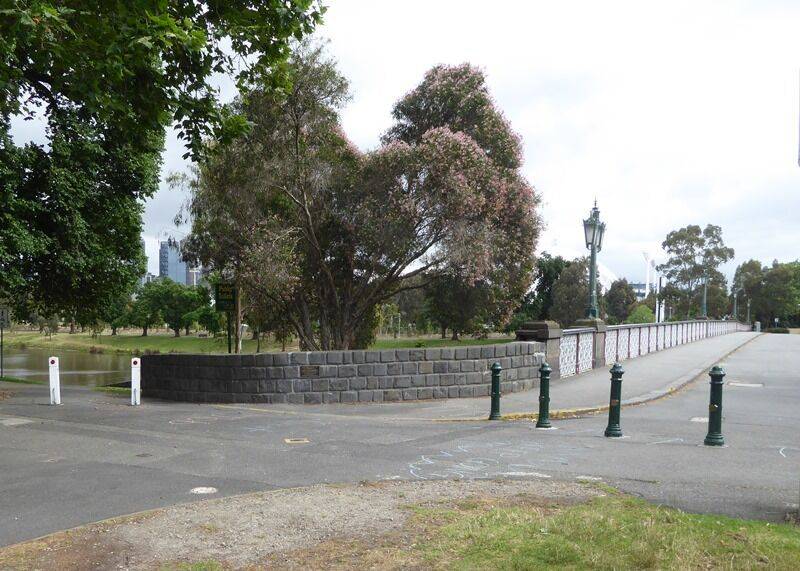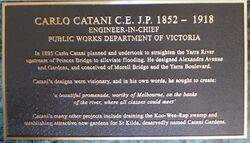
Carlo CataniPrint Page 
The plaque commemorates Carlo Catani, the Italian born civil engineer, who was responsible for the development of Alexandra Gardens and Alexandra Avenue.
After arriving in Australia in 1876 he joined the Department of Lands and Survey as a draftsman who was promoted in time to engineer. Catani was concerned with the widening and improvement of the River Yarra upstream from Princes Bridge, Melbourne.
Through his urging, the scope of the flood mitigation programme was greatly enlarged. Work began in August 1896 and by the winter of 1897 he began to plant elms, oaks and poplars along the left bank and the newly formed Alexandra Avenue. His river works extended upstream as far as Cremorne railway bridge, and included the road bridge at Anderson Street. The laying out and planting of the Alexandra Gardens was executed by the Public Works Department under Catani's direction.
After more than forty-one years of public service that never ended with his retirement, through surveying and direct design, contracting, supervision, and collaborative approaches, perhaps more than any other single figure, Carlo Catani re-scaped not only parts of Melbourne, but extensive swathes of Victoria "from Portland to Mallacoota", opening up swamplands to farming, bringing access to beauty spots, establishing new townships, and the roads to get there.
His park designs were sought after from Albert Park to Warragul, and from the Castlemaine Springs to the St. Kilda Foreshore. His flood protection schemes ranged from the Murray to the Yarra. He envisioned the Yarra Bend Boulevard, a Port Melbourne to Sorrento scenic motorway, he opened up the Mount Buffalo Plateau, and provided access to Arthur's Seat, Mount Donna Buang, and the Grampians' Mc Kenzie Falls.
Alexandra Gardens (1904) with its iconic Federation Star Bed (1906) was his design, and the Queen Victoria Gardens (1913) also bore his contribution. His innovative four lane Alexandra Avenue (1901) and aesthetically conceived Morell Bridge (1899) are also major examples of his talent.
Location
| Address: | Alexandra Avenue & Anderson Street, Morell Bridge, Melbourne, 3000 |
|---|---|
| State: | VIC |
| Area: | AUS |
| GPS Coordinates: | Lat: -37.828082 Long: 144.984846 Note: GPS Coordinates are approximate. |
Details
| Monument Type: | Plaque |
|---|---|
| Monument Theme: | People |
| Sub-Theme: | Government - Colonial |
| Designer: | Carlo Catani Centennial Commemorative Committee, VicRoads, Melbourne Water |
| Link: | http://adbonline.anu.edu.au/adbonli… |
Dedication
| Approx. Monument Dedication Date: | 2020 |
|---|
Carlo Catani C.E. J.P. 1852 - 1918
Engineer-In Chief Public Works Department of Victoria
In 1895 Carlo Catani planned and undertook to straighten the Yarra River upstream of Princes Bridge to alleviate flooding. He designed Alexandra Avenue and Gardens, and conceived of Morell Bridge and the Yarra Boulevard.
Catani's designs were visionary, and in his own words, he sought to create:
'a beautiful promenade, worthy of Melbourne, on the banks of the river, where all classes could meet'
Catani's many other projects include draining the Koo-Wee-Rup swamp and establishing attractive new gardens for St Kilda deservedly named Catani Gardens.






